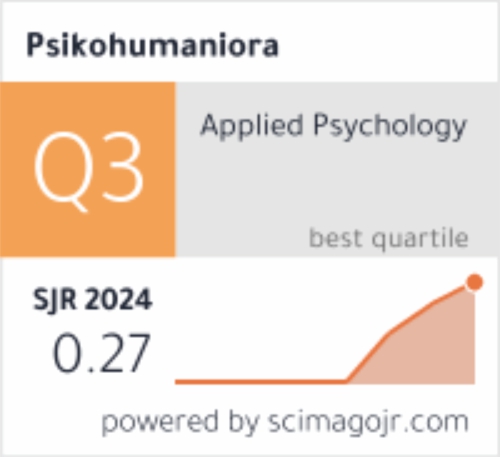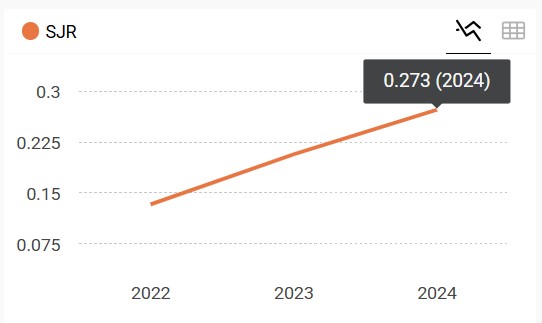Evidence of the validity of the fairness character scale for adolescence: A Confirmatory Factor Analysis (CFA) technique
DOI:
https://doi.org/10.21580/pjpp.v8i1.13589Keywords:
adolescents, fairness, fairness character scale, validityAbstract
The characteristic of fairness is a virtuous one that adolescents should possess as capital to interact with their social environment. However, no validity of evidence supports the score interpretation of a fairness character scale. The purpose of this study is to obtain evidence for the validity of the scale for adolescents. The research data were collected from 532 adolescents in Indonesia, ranging in age between 14 and 18 years. Scale development covers all stages of the process by assessing the required validity and reliability of evidence. Based on the ratings obtained from the scale, exploratory and confirmatory factor analysis were performed to identify the internal structure of the validity evidence. The results of the factor analysis found that the scale consisted of four factors, namely "exploitation", "appreciation", "social role", and "open behaviour". Cronbach alpha's internal consistency value was calculated to be .84. After completing all stages of the scale development, 20 items related to the characteristic of fairness were obtained. Therefore, the scale can be used by positive psychology developers to measure and identify the development of fairness in adolescents in Indonesia. The scale will complement the previously developed character strength measurement tools.Downloads
References
Besnoy, K. D., Dantzler, J., Besnoy, L. R., & Byrne, C. (2016). Using exploratory and confirmatory factor analysis to measure construct validity of the Traits, Aptitudes, and Behaviors Scale (TABS). Journal for the Education of the Gifted, 39(1), 3–22. https://doi.org/10.1177/0162353215624160
Bhatt, K. (2020). Measuring service fairness and its impact on service quality and satisfaction: A study of Indian banking services. Journal of Financial Services Marketing, 25(1–2), 35–44. https://doi.org/10.1057/s41264-020-00069-7
Biçer, N., & Polatcan, F. (2015). Evaluatıon of vocabulary learnıng strategıes ın teachıng Turkısh as a foreıgn language. Atatürk University Journal of Turkish Researches Institute, 54(1), 811–828.
Book, A. S., Volk, A. A., & Hosker, A. (2012). Adolescent bullying and personality: An adaptive approach. Personality and Individual Differences, 52(2), 218–223. https://doi.org/10.1016/j.paid.2011.10.028
Borba, M. (2001). The step by step for building moral intelegenci: The seven essential virtue of moral intelegence. Micheleborba.
Borba, M. (2008). Membangun kecerdasan moral. Gramedia Pustaka Utama.
Büyüköztürk, Ş., & Çokluk-Bökeoğlu, Ö. (2008). Discriminant function analysis: Concept and application. Eurasian Journal of Educational Research (EJER), 8(33), 73–92.
Byrne, B. M., & Campbell, T. L. (1999). Cross-cultural comparisons and the presumption of equivalent measurement and theoretical structure. Journal of Cross-Cultural Psychology, 30(5), 555–574. https://doi.org/10.1177/0022022199030005001
Camerer, C. F. (2003). Behavioural studies of strategic thinking in games. Trends in Cognitive Sciences, 7(5), 225–231. https://doi.org/10.1016/S1364-6613(03)00094-9
Chung, J. Y., & Petrick, J. F. (2015). Measuring price fairness: Development of a multidimensional scale. Journal of Travel & Tourism Marketing, 32(7), 907–922. https://doi.org/10.1080/10548408.2015.1063894
Çokluk, Ş. G. B. Ş. (2010). Sosyal bilimler için çok değişkenli istatistik spss ve lirsel uygulamalar. PegemA.
Coyne, I., Gopaul, A.-M., Campbell, M., Pankász, A., Garland, R., & Cousans, F. (2019). Bystander responses to bullying at work: The role of mode, type and relationship to target. Journal of Business Ethics, 157(3), 813–827. https://doi.org/10.1007/s10551-017-3692-2
Creswell, J. W. (2012). Educational research: Planning, conducting, and evaluating quantitative and qualitative research. Pearson Addison-Wesley.
Devlin, J. F., Kumar Roy, S., & Sekhon, H. (2014). Perceptions of fair treatment in financial services. European Journal of Marketing, 48(7/8), 1315–1332. https://doi.org/10.1108/EJM-08-2012-0469
Hilliard, L. J., Bowers, E. P., Greenman, K. N., Hershberg, R. M., Geldhof, G. J., Glickman, S. A., Lerner, J. V., & Lerner, R. M. (2014). Beyond the deficit model: Bullying and trajectories of character virtues in adolescence. Journal of Youth and Adolescence, 43(6), 991–1003. https://doi.org/10.1007/s10964-014-0094-y
Hooper, D., Coughlan, J., & Mullen, M. R. (2008). Evaluating model fit: a synthesis of the structural equation modelling literature. 7th European Conference on Research Methodology for Business and Management Studies, 195–200. https://doi.org/10.21427/D79B73
Josephson, M. (2006). Making ethical decisions: The six pillars of character. Josephson Institute.
Kline, P. (2014). The new psychometrics: Science, psychology and measurement. Routledge.
Krisnana, I., Rachmawati, P. D., Arief, Y. S., Kurnia, I. D., Nastiti, A. A., Safitri, I. F. N., & Putri, A. T. K. (2021). Adolescent characteristics and parenting style as the determinant factors of bullying in Indonesia: A cross-sectional study. International Journal of Adolescent Medicine and Health, 33(5). https://doi.org/10.1515/ijamh-2019-0019
Kustanti, E. R. (2015). Gambaran bullying pada pelajar di Kota Semarang. Jurnal Psikologi Undip, 14(1), 29–39. https://doi.org/10.14710/jpu.14.1.29-39
Kwak, H., Puzakova, M., & Rocereto, J. F. (2017). When brand anthropomorphism alters perceptions of justice: The moderating role of self-construal. International Journal of Research in Marketing, 34(4), 851–871. https://doi.org/10.1016/j.ijresmar.2017.04.002
Lestari, M. D. (2006). Adaptasi alat ukur values in action inventory strengths pada perawat di Rumah Sakit Cengkareng [Master bachelors thesis]. Universitas Indonesia.
Lopez, S. J., Pedrotti, J. T., & Snyder, C. R. (2018). Positive psychology: The scientific and practical explorations of human strengths. Sage publications.
Macleod, C. M. (2014). Applying justice as fairness to institutions. In A companion to rawls (pp. 164–184). John Wiley & Sons, Inc. https://doi.org/10.1002/9781118328460.ch9
Mar’ati, R. (2014). Pesantren sebagai basis pendidikan karakter: Tinjauan psikologis. Al-Murabbi: Jurnal Studi Kependidikan dan Keislaman, 1(1), 1–15.
Memiş, M. (2018). Impact of derivational morpheme teaching on vocabulary, lexicalization skill and reading comprehension competence of the students learning Turkish as foreign language [Unpublished Doctoral Thesis]. Gazi University Graduate School of Educational Sciences.
Montagna, P., Pierangeli, G., & Cortelli, P. (2010). The primary headaches as a reflection of genetic Darwinian adaptive behavioral responses. Headache: The Journal of Head and Face Pain, 50(2), 273–289. https://doi.org/10.1111/j.1526-4610.2009.01584.x
Olaniyi, A. A. (2019). Application of Likert scale’s type and Cronbach’s alpha analysis in an airport perception study. Scholar Journal of Applied Sciences and Research, 2(4), 1–5.
Osborne, J. W. (2014). Best practices in exploratory factor analysis. CreateSpace Independent Publishing.
Padilla, S. L., Qiu, J., Soden, M. E., Sanz, E., Nestor, C. C., Barker, F. D., Quintana, A., Zweifel, L. S., Rønnekleiv, O. K., Kelly, M. J., & Palmiter, R. D. (2016). Agouti-related peptide neural circuits mediate adaptive behaviors in the starved state. Nature Neuroscience, 19(5), 734–741. https://doi.org/10.1038/nn.4274
Pala, A. (2011). The need for character education. International Journal of Social Sciences and Humanity Studies, 3(2), 23–32.
Park, N., & Peterson, C. (2008). Positive Psychology and character strengths: Application to strengths-based school counseling. Professional School Counseling, 12(2), 2156759X0801200. https://doi.org/10.1177/2156759X0801200214
Park, N., & Peterson, C. (2009). Character strengths: Research and practice. Journal of College and Character, 10(4). https://doi.org/10.2202/1940-1639.1042
Randa, R., Reyns, B. W., & Nobles, M. R. (2019). Measuring the effects of limited and persistent school bullying victimization: Repeat victimization, fear, and adaptive behaviors. Journal of Interpersonal Violence, 34(2), 392–415. https://doi.org/10.1177/0886260516641279
Rubin, K. H., Bukowski, W. M., & Parker, J. G. (2006). Peer interactions, relationships, and groups. In Handbook of child psychology: Social, emotional, and personality development (pp. 571–645). John Wiley & Sons, Inc.
Rubini, B., Permanasari, A., & Permana, I. (2018). Building character through science learning with scientific literacy based. IOP Conference Series: Materials Science and Engineering, 288, 012030. https://doi.org/10.1088/1757-899X/288/1/012030
Ruch, W., Proyer, R. T., Harzer, C., Park, N., Peterson, C., & Seligman, M. E. P. (2010). Values in Action Inventory of Strengths (VIA-IS). Journal of Individual Differences, 31(3), 138–149. https://doi.org/10.1027/1614-0001/a000022
Sanaoui, R. (1995). Adult learners’ approaches to learning vocabulary in second languages. The Modern Language Journal, 79(1), 15–28. https://doi.org/10.1111/j.1540-4781.1995.tb05410.x
Saydam, M. (2018). Research on Turkish teaching course books as a foreign language in terms of word teaching strategies [Unpublished Master Thesis]. Yıldız Technical University Graduate School of Social Sciences, Istanbul.
Scaini, S., & Caputi, M. (2018). The interaction between psychopathological symptoms and conflictual parent-child relationship in predicting social skills and coping strategies. International Journal of Emotional Education, 10(2), 159–162.
Seligman, M. E. P. (2019). Positive Psychology: A personal history. Annual Review of Clinical Psychology, 15(1), 1–23. https://doi.org/10.1146/annurev-clinpsy-050718-095653
Setyaputri, N. Y., Krisphianti, Y. D., & Puspitarini, I. Y. D. (2018). Permainan roda pelangi sebagai media untuk meningkatkan karakter fairness siswa sekolah dasar. Jurnal Kajian Bimbingan Dan Konseling, 3(3), 108–118. https://doi.org/10.17977/um001v3i32018p108
Siengsukon, C. F., Nelson, E., Williams-Cooke, C., Ludwig, R., Beck, E. S., Vidoni, E. D., Mahnken, J. D., Stevens, S., Drerup, M., Bruce, J., & Burns, J. M. (2020). Cognitive behavioral therapy for insomnia to enhance cognitive function and reduce the rate of Aβ deposition in older adults with symptoms of insomnia: A single-site randomized pilot clinical trial protocol. Contemporary Clinical Trials, 99, 106190. https://doi.org/10.1016/j.cct.2020.106190
Sivo, S., Shannon, K., Fox, J., Taub, G., & Robinson, E. (2017). Structural analysis of character education: A cross-cultural investigation. School Psychology Forum, 11(2), 34–44.
Soetoprawiro, K. (2010). Keadilan sebagai keadilan. Jurnal Hukum Pro Justitia, 28(2), 229–256.
Sulaiman, S., Abdullah, M. A., Mansur, T. M., & Zulfan, Z. (2014). Pembangunan hukum perlindungan nelayan tradisional di Aceh dalam kaitan pemanfaatan sumber daya perikanan secara berkeadilan. Jurnal Media Hukum, 21(2), 309–321. https://doi.org/10.18196/jmh.v21i2.1195
Suparwi, S. (2014). Perilaku bullying siswa ditinjau dari persepsi pola asuh otoriter dan kemampuan berempati. Inferensi: Jurnal Penelitian Sosial Keagamaan, 8(1), 159–179. https://doi.org/10.18326/infsl3.v8i1.159-179
Tabachnick, B., & Fidell, L. (1996). Using multivariate statistics. Harpercollins College Publishers.
Tavşancıl, E., & Keser, H. (2002). İnternete yönelik likert tipi bir tutum ölçeğinin geliştirilmesi. Eğitim Bilimleri ve Uygulama, 1(1), 79–100.
The Indonesian Child Protection Commission. (2022, August 24). Data kasus perlindungan anak 2021. Bank Data Perlindungan Anak. https://bankdata.kpai.go.id/tabulasi-data/data-kasus-perlindungan-anak-2021
The National Consortium for Character Development. (2020). Verbal bullying untuk dapatkan popularitas.
Ting, S.-C. (2013). Service Fairness Scale: Development, validation, and structure. International Journal of Marketing Studies, 5(6), 25. https://doi.org/10.5539/ijms.v5n6p25
van Dijk, E., & Vermunt, R. (2000). Strategy and fairness in social decision making: Sometimes it pays to be powerless. Journal of Experimental Social Psychology, 36(1), 1–25. https://doi.org/10.1006/jesp.1999.1392
Wang, Y., Derakhshan, A., & Zhang, L. J. (2021). Researching and practicing positive psychology in second/foreign language learning and teaching: The past, current status and future directions. Frontiers in Psychology, 12, 731721. https://doi.org/10.3389/fpsyg.2021.731721
Yang, C., Sharkey, J. D., Chen, C., & Jimerson, S. (2019). Teacher-home communication and bullying victimization: Do parents’ perceptions of fairness of rules matter? School Psychology Review, 48(3), 251–266. https://doi.org/10.17105/SPR-2018-0060.V48-3
Yığın, M. (2013). Vocabulary learning strategies the learners use in teaching Turkish as a second language [Unpublished Master Thesis]. Çanakkale On Sekiz Mart University.
Downloads
Published
How to Cite
Issue
Section
License
The copyright of the accepted article shall be assigned to the publisher of the journal. The intended copyright includes the right to publish the article in various forms (including reprints). The journal maintains the publishing rights to published articles.
In line with the license, authors and any users (readers and other researchers) are allowed to share and adapt the material only for non-commercial purposes. In addition, the material must be given appropriate credit, provided with a link to the license, and indicated if changes were made. If authors remix, transform, or build upon the material, authors must distribute their contributions under the same license as the original.



